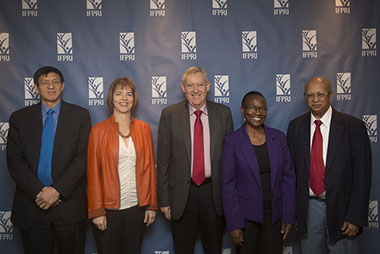One in three people in the world is malnourished. Deficiencies in vitamins and minerals such as vitamin A, iron, and zinc can cause blindness, reduced IQ, vulnerability to disease, and even death. Biofortification—breeding new, more nutritious varieties of staple food crops to increase their micronutrient content—is one promising approach for combatting micronutrient malnutrition among vulnerable groups in many developing countries.
Thanks to the work of HarvestPlus and its partners, biofortified crops—namely vitamin A sweet potatoes, iron beans, and high zinc rice and wheat—are now being grown by farmers and consumed by millions of families every year in more than 30 countries throughout the world.
The program has an even more ambitious goal: to reach one billion people by 2030. Can it be done? How?
At a recent IFPRI policy seminar, a panel of experts from HarvestPlus as well as the research and NGO community discussed ways to scale up biofortification and ensure that nutrition remains a global priority.
- Mainstream it.
To reach one billion people, biofortified crops must be mainstreamed into the strategies and plans of a wide range of development organizations, governments, and companies. According to Howarth Bouis, Director at HarvestPlus, this process already is well underway: the World Bank, the International Fund for Agricultural Development, the UN World Food Programme, the African Union, international NGOs such as World Vision, national governments, and private seed companies all either are including or have plans to include biofortified crops into their programs. - Reach more urban people.
”If we want to reach a billion people, we also have to reach the urban population,” said Anne Marie Ball, HarvestPlus manager of partnerships in Africa. Some city supermarkets are already offering products made with biofortified crops, such as bread from orange sweet potato. “When mothers know that vitamin A is in the food, they make a choice. You want a better future for your children.” - Convince national policymakers.
Mahabub Hossain, an advisor at BRAC and a member of the Global Panel on Agriculture and Food Systems for Nutrition, emphasized the importance of getting national policymakers on board—particularly ministers of finance. “It’s more than an issue of nutrition,” he said, noting that messages that show the link between good nutrition and economic productivity are powerful. - Partner with private companies.
The panelists agreed that engaging the private sector is crucial to expanding biofortification’s reach. This, too, is already underway. Seed companies like Zamseed in Zambia and Nirmal Seed in India are now marketing and selling biofortified seeds. To scale up, HarvestPlus and their partners must get even more private sector partners on board, and bigger ones. - Create incentives and move demand.
Demand for biofortified crops is already high—but it could be even higher. If countries establish national biofortification policies, enacting laws to sell more nutritious varieties of seeds and crops, and if companies see the benefit in buying and processing these crops from farmers, that will go a long way toward spurring demand. Having the right economic incentive structures in place also will ensure current efforts to scale up biofortification won’t take a step backward. As Bonnie McClafferty, formerly with HarvestPlus, put it, “Farmers will move away from [vitamin A] maize if they can make more money on [traditional] rice.”
In his concluding remarks, IFPRI Director General Shenggen Fan reminded the audience not to forget the roles of trade and policy research. “These are policy issues,” he said. “Research on policy can identify successes and help us scale them up.”
All agreed that there is no one solution to malnutrition. “A diverse diet is where we want to be,” said Bouis. “We need all pieces of the puzzle, and agriculture has to be part of the solution.” The other pieces of the nutrition puzzle? Vitamin and mineral supplementation and commercial fortification.
Reaching one billion people at risk of hidden hunger with biofortified crops will represent a key step toward achieving the recently adopted UN Sustainable Development Goal of ending hunger and malnutrition by 2030.







